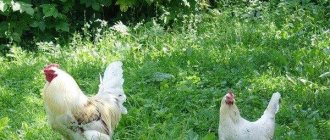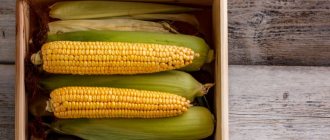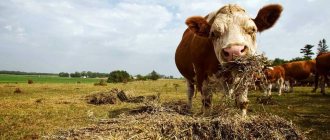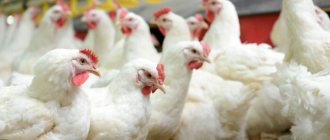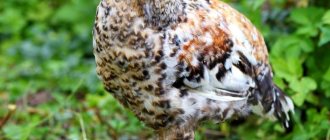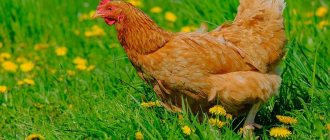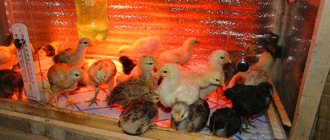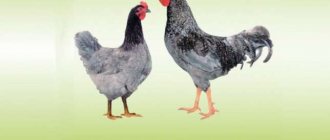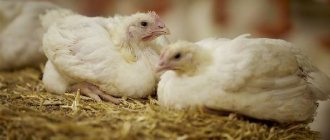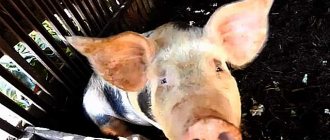1 850
no comments yet
0
Author:
Smirnov Alexey.
Reading time: 2 minutes
Mineral supplements that serve as a source of calcium, sodium and phosphorus must be introduced into the chickens' diet. They are necessary for the formation of bones, eggshells, are an important part of the internal organs of the bird and serve to increase egg production.
Mineral feeds must be provided to birds constantly, especially in winter, when birds do not use walking range or have limited access to it.
With a lack of minerals, chickens develop diseases such as rickets, osteoporosis, dystrophy and bone deformities, and the normal growth of the bird also slows down. In laying hens, the first thing that suffers is the quality of the eggshell: it becomes soft and easily damaged during the process of egg formation, so pathogenic microbes can get into it.
One such mineral supplement is chalk.
Mineral composition and beneficial properties
Feed chalk contains several main mineral elements:
- Calcium (37%) is the main component of the bait. It participates in the formation of bone, nervous and muscle tissue, regulates metabolic processes, promotes better absorption of iron, cleanses the body, and prevents the development of dystrophy in young animals. A sufficient amount of calcium in the diet ensures better taste of meat and eggs, prevents eggs from pecking in the winter, and promotes faster weight gain.
- Phosphorus (0.18%) takes part in the mineralization of the skeleton, preventing the development of dystrophy, and is involved in many metabolic processes in the body.
- Potassium (0.5%) primarily regulates the metabolism of calcium, phosphorus and vitamin D3. In addition, it participates in the synthesis of amino acids and lipids, is responsible for the quality of feathers, improves appetite and helps increase egg production.
- Sodium (0.3%) along with potassium is necessary for the formation of eggshells.
Sufficient presence of chalk in the diet:
- increases egg production by 20%;
- increases broiler weight gain;
- promotes rapid growth of chickens;
- promotes rapid restoration of plumage during the molting period;
- prevents bone diseases.
Standards for obtaining carbohydrates, fats and proteins
Proper nutrition of laying hens consists of receiving a balanced feed containing proteins, fats and carbohydrates. Egg production directly depends on the birds’ nutrition. Compound feeds come in the following varieties:
- Protein. Source of plant and animal proteins.
- Vitamin. The food is intended to replenish the supply of vitamins and provitamins.
- Mineral. Fills the body with minerals.
- Carbohydrates. They contain flour mixtures, grain mixtures, root vegetables, vegetables, bran, and cereals.
One chicken contains from 60 to 70% carbohydrates, from 15 to 18% proteins, from 4 to 6% fiber, from 3 to 5% fat. This is enough chicken a day to replenish your energy reserves. It is important that laying hens receive the required amount of protein, since 80% of it is used to form eggs.
You can supplement your diet with vegetable proteins by including mixtures of oil cake, sunflower or rapeseed. To replenish animal proteins, it is recommended to feed chickens with waste from meat and fish. You can also feed birds with bone meal, insects, and earthworms. It is equally important to ensure the supply of fats; they also affect the formation of eggs. It is necessary to include oats, corn, pumpkin, and sunflower in the diet.
Carbohydrates are the basis that ensures the vital functions of the chicken’s body as a whole. To obtain carbohydrates, feed laying hens bran, grains, and root vegetables.
Which chalk should you choose?
It is best to use a special feed additive. It is purified from impurities, including toxic ones, and contains up to 75% beneficial substances. Ready-made fertilizer is sold in stores in packages of 2 and 5 kg. It can be added to mixtures with wet food. Other types of feeding you can give:
- limestone flour, rich in calcium and magnesium;
- tricalcium phosphate, which contains, in addition to calcium, phosphorus and sodium (all components in an easily digestible form);
- shell rock, which in addition to calcium contains iodine and magnesium.
Farmers sometimes resort to using limestone (it contains 35% of useful substances) or construction chalk. The latter substance is undesirable, but acceptable, and it must be pre-prepared. Under no circumstances should you give quicklime! This can cause burns to the mucous membrane!
Effect of feeding shell
Before feeding chickens with shells, you need to familiarize yourself with their effect on the body:
- helps restore calcium balance in the body;
- improves the absorption of chicken feed by stimulating the gastrointestinal tract and increasing the amount of gastric juice secreted;
- shells contain microelements that prevent the appearance and development of hermaphroditism;
- strengthen the body in chickens that do not absorb vitamin D well;
- strengthening egg shells, which become many times stronger and stronger over time;
- strengthening the immune system;
- improving the general condition and appearance of young laying hens.
How much do you need?
To ensure proper functioning of the body, an adult must consume at least 3.5 g of chalk per day.
Adult laying hens
Before laying begins, the hen begins to accumulate calcium. During this period, her body absorbs up to 70% of the chalk eaten. She will use these reserves in the future. When the shell is formed, the chicken receives only part of the calcium from food (about 1.3 g), and the rest (0.7 g) from internal reserves.
The process of forming an egg takes about 20 hours, and the shell takes another 6 hours. During this period, calcium consumption reaches 0.3 g of calcium per hour, which, of course, should be constantly restored.
Chickens and young animals
Children need chalk feeding for the prevention of diseases, healthy growth and development of the body. The supplement begins on day 10, and after a certain period the amount is increased:
- from 10 to 20 days – 13 g per day per 10 heads;
- from 21 to 30 - 18 g;
- from 31 to 40 – 23 g;
- from 41 to 50 – 28 g;
- from 51 to 60 – 33 g;
- from 61 to 90 – 38 g;
- from 91 days to 4 months – 43 g.
Starting from the age of four months, young animals should be given 50 g of chalk per day per 10 animals.
You can read about how to properly give salt to chickens here.
What are the dangers of a lack of minerals in a chicken’s diet?
A common problem when keeping chickens is thin and deformed shells on eggs, especially in the first weeks of laying. There are cases when eggs do not have a hard surface at all and are contained in a shell, this indicates a gross disturbance in the birds’ nutrition and a catastrophic lack of calcium.
A lack of minerals has a number of negative consequences:
- Cannibalism among chickens.
- Digestive and metabolic disorders.
- Fragility of the musculoskeletal system.
- Death of young animals.
- Frequent illnesses and weak immunity.
- Decreased productivity.
It is important to replenish the calcium deficiency in time, especially for young egg laying hens, otherwise the first clutch will be without a shell. In addition, the taste of the eggs and the appearance of the chicken will deteriorate.
How to give?
Chalk is not given as a separate component in dry form: a chicken will not be able to swallow such food. It definitely needs to be mixed with something. Traditionally, the mineral is added to chickens' wet mashes. It is necessary to ensure that the feeding is small enough and does not form lumps, since this will make it difficult to swallow and, as a result, the chicken may not receive the daily requirement of minerals. Some farmers resort to using special bedding, 75% chalk. Chickens swarm in it, peck and thus get the required amount of substances. This bedding is also beneficial because it perfectly absorbs moisture and prevents the development of pathogenic microflora.
Bird feeders
You can make so-called bunker feeders for chickens based on a sewer pipe. It will be quite cheap, but the animals will have regular access to their food, and they will not be able to dig up food. a feeder of this type must be protected from above in the form of a canopy to protect the food from rainwater. You can also make your own drinking bowls on a similar basis.
If you understand the needs of animals at a sufficient level, then any desire to engage in this business will disappear and, in general, it will be easier to buy store-bought eggs. However, in reality, everything is not as complicated as it might seem. Laying hens are characterized by independent regulation, and therefore it is enough just not to overdo it with the dosage of one or another component per day and the bird’s body will independently bring the indicator to the desired level.
In addition, to feed the bird, you can resort to nutrition such as pelleted feed. Using it automatically can be cheaper than making healthy mash yourself. The composition and price of feed mixtures are different. The cost depends on many factors. If you follow proper care, you will raise healthy and active birds. It is better to give leftover food to other animals if they eat it, for example for a cat or dog. Cats can be fed many foods without harm to their health.
Features of using construction chalk
As noted above, the use of construction chalk for feeding chickens is an extreme and undesirable measure. But if there are no other options, then it should be used, otherwise the bird will begin to have health problems.
First of all, you should remember that construction chalk should never be given in its pure form: it contains many harmful impurities (gypsum, marble) that can affect the condition of the bird.
You may also be interested in the article: “When and why to give yeast to laying hens and broilers?”
In order for building material to be given to chickens as food, it should be prepared:
- Mix in equal proportions with water.
- Let it sit.
- Drain the water.
- Dry the sediment well.
- Select large solids that the chicken will not be able to swallow.
This material is more suitable for adding to the diet of chickens.
Diet
For good egg production of chickens and high nutritional value of eggs, include certain types of feed in the chickens' diet.
Mineral feed
Provide laying hens:
- calcium;
- phosphorus;
- chlorine;
- sodium;
- iron.
Maintains shell strength.
Mineral feeds are chalk, shells, limestone, feed phosphates, table salt. Grind them well. Mineral additives are mixed with grain and added to the wet mash.
Protein
Protein is a building material for the chickens’ body.
Proteins are provided by food of plant and animal origin. Plant proteins are found in:
- legumes;
- meal and cake;
- yeast;
- nettle flour.
Animal proteins are found in:
- whole and skim milk;
- cottage cheese;
- fish and meat and bone meal.
Tip: Do not overfeed egg-laying chickens with fishmeal. Eggs may have an unpleasant taste.
Vitamin
Replenish the supply of vitamins, increase immunity and the survival rate of chickens.
Recommended:
- grated carrots;
- fresh greens in summer and dry hay in winter;
- tops;
- grass and pine flour.
Rich in carbohydrates
This group of feeds includes cereals and vegetables.
Cereals:
- wheat;
- oats;
- barley;
- millet;
- sorghum;
- corn.
Experienced farmers recommend germinating some of the grain. This increases the vitamin E content in cereals.
Vegetables
Vegetable crops:
- potato;
- roots.
A real delicacy that all chickens are partial to is melons.
A high carbohydrate content is found in bran. They are added to dry and wet feed mixtures.
Conclusions:
- It is necessary to give chalk to chickens. It is a source of calcium and several other minerals involved in the formation of most body tissues. Calcium is especially important for the prevention of bone diseases and the formation of hard shells in eggs.
- It is best to use a special feed additive for complementary feeding: it is well purified and rich in nutrients.
- You can find several varieties of bait in stores. However, if it is not possible to purchase a special composition, you can resort to improvised means, for example, construction chalk. However, in this case it must be specially prepared.
- Chickens should receive chalk from 7-10 days until the end of their lives, and the dosage will be different at each age. On average, a healthy adult chicken should receive at least 3.5 g of chalk per day, and for laying hens this daily dose of chalk should be increased to 4 g.
Indications for introducing shells into the diet of domestic chickens
It is recommended to introduce a mineral supplement from the second week of life to strengthen the skeleton of chicks, as well as to prevent rickets. At the age of 3.5-4 months, increase the dosage to 2-3 grams, this is necessary for preparing and starting the first clutch. The egg shells will be quite strong and smooth, and the laying hens will not peck at the products.
In winter, the shell is especially useful, it accelerates molting and serves as an ideal prevention of hypovitaminosis and vitamin D deficiency. It is added to porridge and mixed feed, which makes it easier to swallow grains of sand without irritating the mucous membrane of the throat, and also enriches food with minerals and improves its digestion.
Important! Timely feeding with shellfish will speed up the molting process, improve the egg production of chickens and protect chickens from rickets.
Why do eggs have soft shells?
As mentioned above, calcium deficiency leads to a wide variety of masonry problems. One of the common pathologies resulting from calcium deficiency is the appearance of soft-shelled eggs.
Look at the photo: overnight the soft-shelled egg dried out and began to look very original!
On average, a chicken spends up to 2 grams of calcium to produce one egg, of which 60% is mineral compounds from food, and 40% is an element produced by the body. Therefore, even one day without using calcium supplements can result in soft-shelled eggs. But it is important to understand that it is not only the absence or deficiency of calcium that causes this problem.
There are other factors that influence this. Laying hens produce soft-shelled eggs in the following situations:
Dry food
If you prepare chicken feed yourself, you need to adhere to a specific percentage. Dry food for laying hens is not contraindicated and at different times some breeds consume this type of nutrition. To correctly create a chicken diet, you can read reviews from laying hen owners and draw certain conclusions for yourself. The chicken does not eat barley, mash with rice, pasta or lard.
At home, it is correct to give the following necessary proportions of nutrition in the diet of laying hens per day:
- 70% grain
- 7% need to be fed wheat
- 8-15% meal/cake
- 4-6% fish, meat or bone meal
- 3-6% yeast feeding or yeasting
- 3-4% feed fat
- 3-5% feed meal
- 7-9% mineral and vitamin impurities
In the case of a dry type of bait, it is best if the bird is given a complete combined feed that contains everything it needs. The combined feed is given no more than 120 grams per day for one chicken.
Wood ash
Contains a complex of minerals, in particular: calcium 33%, phosphorus 2%, sodium 9%, potassium 7%, magnesium 7%, manganese 0.47%, iron 0.8%. They feed it at the rate of 10 grams per head or in a separate container in the form of coal ad libitum.
If you give your chickens baths to bathe in ash, you won’t need to add any additional ash to the feed. This achieves two goals.
This is lake silt, which contains protein (up to 6%), calcium (1.2%), as well as other trace elements. Used as a complex additive at the rate of 20 grams per head for chickens and 5-15% of the diet for chickens.
Why do you need gravel?
A few words about gravel. It is often put on a par with mineral supplements, although this is incorrect. The function of gravel is to serve as teeth for the bird. Once in the gizzard, the gravel settles there and contributes to the grinding of the grain.
Therefore, good gravel should be clean, free of dirt and fine sand, and not dissolve in water or acid. The gravel size for chickens should be 4-6 mm, for smaller chickens - 2-3 mm.
Gravel can be given ad libitum in bulk on the bedding, in a separate container, or introduced into the feed once a week in the amount of 10-15 grams per head. If the bird is kept free-range, it is not necessary to provide gravel.
Different fractions of gravel are given to the bird depending on size and age.
